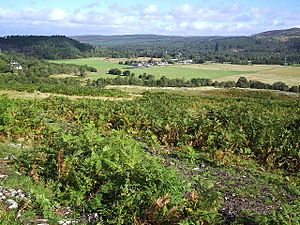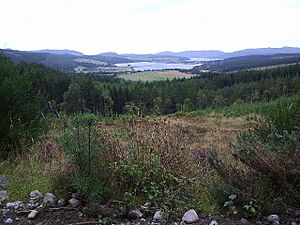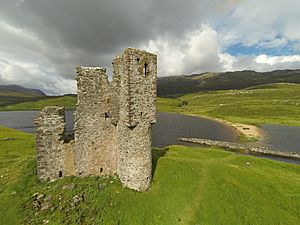Battle of Carbisdale facts for kids
Quick facts for kids Battle of Carbisdale |
|||||||
|---|---|---|---|---|---|---|---|
| Part of Scotland in the Wars of the Three Kingdoms | |||||||
 The Royalists were in the field to the left of the village, and fled up the hill in the top-left of this photo |
|||||||
|
|||||||
| Belligerents | |||||||
|
|
|||||||
| Commanders and leaders | |||||||
| Strength | |||||||
| 300 men (five troops of cavalry and a group of musketeers) 400 clansmen (from Clan Munro and Clan Ross) |
50 cavalry 1,000 infantry (from Orkney) 500 mercenaries (Swedish, German and Danish) |
||||||
| Casualties and losses | |||||||
| Two men wounded and one drowned, "low" | 450+ killed + 200 drowned 400 plus captured |
||||||
| Designated | 30 November 2011 | ||||||
| Reference no. | BTL19 | ||||||
The Battle of Carbisdale was a big fight that happened near Culrain, Sutherland, Scotland on April 27, 1650. It was part of a larger conflict called the Wars of the Three Kingdoms. This battle was fought between the Royalists, led by James Graham, 1st Marquess of Montrose, and the Scottish Government. The government was controlled by a group called the Covenanters, who were against the king. The Covenanters won this battle in a big way.
Contents
Why the Battle Happened
After a war in England in 1648, the Covenanters took control of the Scottish government. They were very upset when King Charles I was executed in 1649. They quickly announced his son, Charles II, as the new king. However, Charles II had to agree to their rules to get their full support.
Meanwhile, James Graham, 1st Marquess of Montrose, a strong supporter of the king, wanted to help Charles II get back his power. He suggested starting a fight in Scotland. In February 1649, Charles II made Montrose a top general in Scotland. Montrose hoped to gather a large army to fight for the king.
Montrose Lands in Orkney
Montrose planned to raise a huge army, especially from the Scottish Highlands. But things didn't go as he hoped. The local clans didn't join him, and he didn't have enough foreign soldiers. By April 1650, Montrose had only about 400 to 500 Danish troops and 1,000 men from Orkney. Most of the Orcadian men were just fishermen and farmers, not trained soldiers.
Montrose's commanders included experienced soldiers and mercenaries (paid fighters). One of them was Sir John Urry. Urry and 500 men went ahead to find a safe place to land on the Scottish mainland. They easily found a spot at the Ord of Caithness. Montrose and the rest of his army followed on April 12, 1650. They hid in the hills to stay safe from the Covenanter cavalry.
On the other side, the Covenanters had several castles guarded. John Gordon, 14th Earl of Sutherland also supported the Covenanters. Montrose moved quickly, landing in John o' Groats and marching to Thurso. He took Dunbeath Castle after a short fight.
Montrose then joined up with Urry, having about 800 men left. He tried to go inland, hoping for support from the Clan Munro and Clan Ross. But these clans actually supported the Covenanters. The Covenanter general, Strachan, gathered his forces. He had 220 experienced cavalry, 36 musketeers, and 400 clansmen from Clan Munro and Clan Ross. These were the very clans Montrose had hoped would join him!
Strachan's Clever Plan
On Saturday, April 27, 1650, Strachan marched his troops west. Montrose had set up camp near the Kyle of Sutherland, waiting for more support. Strachan knew where Montrose was. He needed to trick Montrose's army into coming down from the hill to flatter ground, where his cavalry could be more effective.
Strachan hid most of his cavalry among the bushes. He sent out just one troop of horsemen. Montrose's scouts saw only this small group and reported that there were very few enemy soldiers. This was exactly what Strachan wanted!
Montrose ordered his foot soldiers to advance, not expecting a big fight. Strachan then brought out the rest of his cavalry. He divided them into three groups. Another group included his musketeers and the Munro and Ross clansmen.
The Battle at Carbisdale

Strachan's plan worked perfectly. He attacked Montrose's small group of horsemen, pushing them back into their own infantry. Montrose's foot soldiers, about 1,200 men (mostly untrained Orcadians), were not ready for a cavalry charge.
While the German and Danish mercenaries tried to hold their ground, the Orcadian soldiers panicked and ran. Strachan's reserves, including his musketeers and the Munro and Ross clansmen, then attacked the Royalists. Montrose's army was completely overwhelmed. Many of the Orcadians were killed or drowned while trying to cross the Kyle of Sutherland.
Montrose himself was hurt several times, and his horse was shot. He managed to escape on another horse. In the end, Montrose lost about 450 men killed and another 200 drowned. About 400 soldiers and 58 officers, including Urry, were captured. Strachan, on the other hand, lost only two men wounded and one drowned.
Historians wonder if Montrose's scout, Robert Munro of Achness, might have given him bad information on purpose. This could have led Montrose into the trap.
Montrose's Capture and End

After the battle, Montrose tried to escape by disguising himself as a shepherd. He eventually reached Ardvreck Castle, hoping to find safety. However, the castle owner, MacLeod of Assynt, was away. Montrose was met by MacLeod's wife, Christian Munro, whose father had fought against Montrose at Carbisdale. She had Montrose captured and held in the castle.
MacLeod of Assynt was given a large reward for turning Montrose over to his enemies. Montrose was taken to Edinburgh. He was executed on May 21. His body was later honored with a grand state funeral in Scotland. Years later, his great-grandson became the first Duke of Montrose.
Images for kids
-
Carbisdale Wood, looking towards Bonar Bridge down the Kyle of Sutherland and with Culrain in the foreground
-
Ardvreck Castle where Montrose surrendered to Neil Macleod of Assynt after the Battle of Carbisdale




